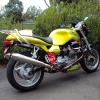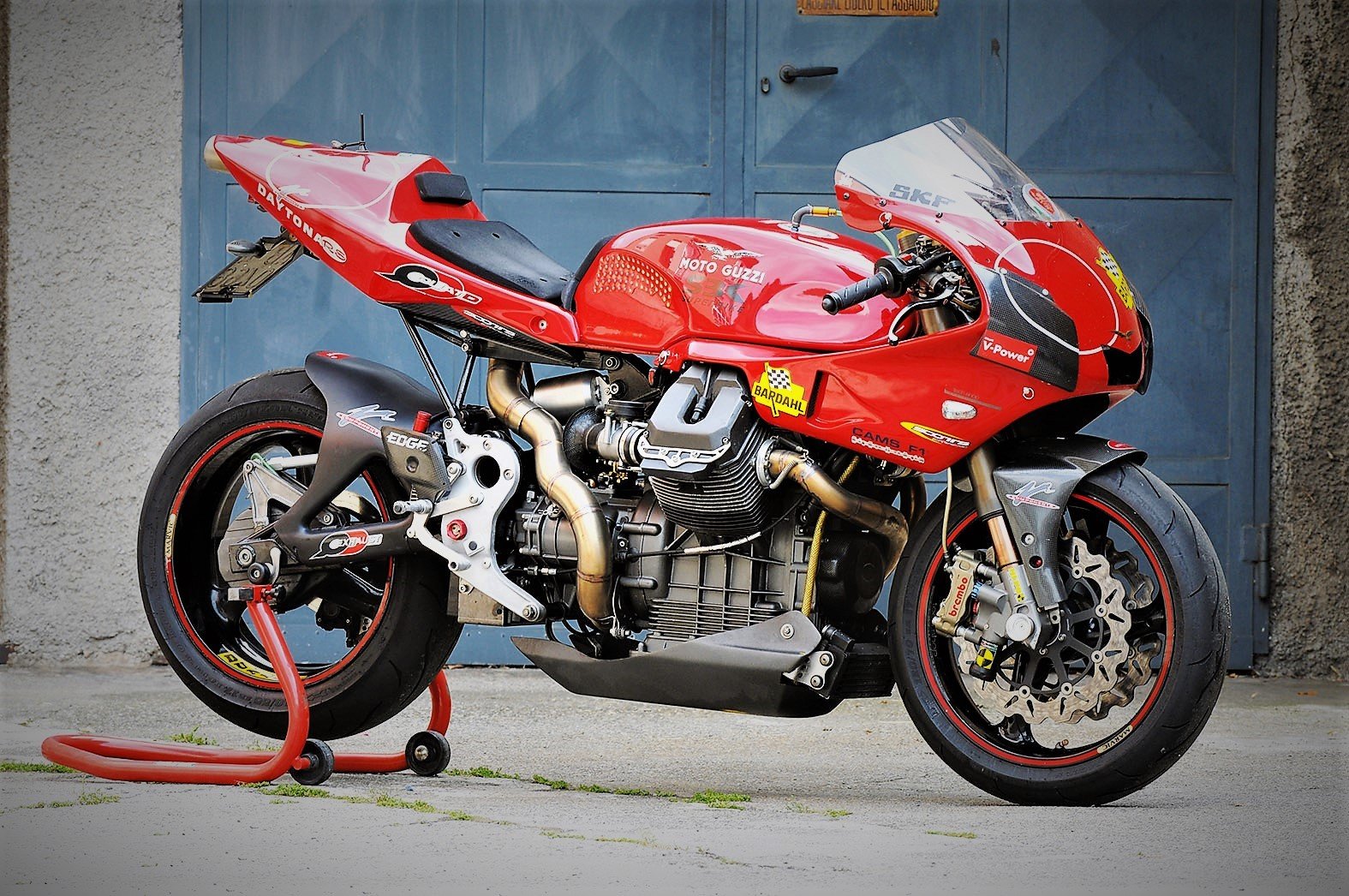-
Posts
5,215 -
Joined
-
Last visited
-
Days Won
268
Content Type
Profiles
Forums
Events
Gallery
Community Map
Everything posted by Lucky Phil
-
Too small to read these. The are fine sitting on the parked bike but when you're riding they are too small to read at a glance. and a glance is all you should need. My RE650 has this fitted and it's the same issue. It's not that you can't read them while riding it's just they aren't a "glance and read" proposition unlike the Formotion fitted to the Guzzi. Digital are probably the best on a bike. Phil
-
Why docc? you mean for corrosion protection? Phil
-
I dont know whether sealed is optimal or not I've never use the grease nipple and just lubed it by hand as pressureangle suggested. My bike doesn't do lots of miles though. I would assume that any time the end is filled with grease and it's compressed grease just forces it's way past he oring? not sure. Phil
-
I have a brand new drive shaft assembly as a spare and there is no bleed holes. So the yoke and shaft with the splines is one casting with a blanking cap fitted from the yoke end and staked in place. The flat sections you can see are the staking marks. The cap seats on the end of the splines internal end face. I would just clean out the grease thoroughly and drizzle some 5 min Araldite or the resin of your choice down inside the splined section to seal the cap from the inside. a small syringe and 1-2ml of resin. Easy. Phil
-
Well if you change the bottom tree offset and leave the top the same then the fork leg bores need to be bored at a slight angle so they align. So now on the later forks the stem and the fork legs are not parallel. Just like an RC30 Honda and others for example. So the top and bottom triples are a matched set between the earlier and later. Phil
-
So here is the definitive answer to the triple clamp offset question. Twenty years in the pursuit. This is what you get when you use a later top clamp on an early lower clamp with fork tubes fitted. The stem doesn't line up with the stem bore due to the different lower clamp offset. Another difference between the later and earlier lower clamps is the steering damper lug is 7mm longer on the later clamps so you need to machine that amount off the later clamps for the steering damper to fit correctly.
-
I had the front wheel out a few days ago and the new wheel with the 25mm hollow axle and new tyre and disks is 2.2 KG lighter than the old front wheel, axle, disks and a partially worn tyre. So both wheels, the Titanium rear axle and the 25mm hollow front axle and bevel shroud removal saves 8.2 KG total. Not bad. I should have weighed the later clip ons as they are sure to be a bit lighter then the swan neck versions. I must weigh the bike and see whats the total weight. The 4 valve engine will weigh a fair bit more of course but the cross over and mufflers will be a lot less. Phil
-
You don't really need to do this. You must keep the pates in the correct body and orientation upstream to downstream but when you install them you simply shut the throttle shaft hard with the plate loose and tap it a little to set the plate perfectly in the bore then tighten the screws. You need to clean up the screw threads and remove the staking and apply Loctite. I use blue and also mark the heads so I can check them from time to time. Phil
-
Now you'll have an issue with damaged threads in the throttle shafts. Phil
-
Why are you messing with them? I've had a few out for throttle body re bushing and new seals and they are staked in. You need to grind the tail of the screw to remove them. Never any need to touch them otherwise.
-
Well mine are beautiful wheels but the front wheel didn't fit the bike when delivered. The rear drive assembly was a very nice piece but the rear disk brake carrier had .2mm of runout! I removed it and machined it true. The front wheel wouldn't fit as the brake calliper bodies dragged on the disks because the captive spacer was 2mm too long. I had to press that out and machine it down and then it fitted. I emailed Roland about it with images of the measurements and dial indicator readings but he just told me to send them back to PVM. Not that useful to me so I fixed them myself. I think there has been changes at PVM and maybe they aren't interested in bespoke work anymore. Don't know for sure. Add that to the many issues I've had as a foreign customer with different German suppliers over the last 2 year or so and I'm not keen to buy from them anymore. Don't know whats happened there but they are now far worse than the Italians ever were. Strange that and directly opposite to my old and pretty comprehensive dealing with them around 30 years ago. Phil
-
Yes they were a special order. Roland doesn't seem to be listing them anymore which doesn't surprise me. Phil
-

Re-assembling the Tranny Pre Selector Assembly
Lucky Phil replied to mznyc's topic in Technical Topics
Pretty much. I did a how to post years ago. It's all pretty straight forward. High points Don't attempt to adjust the main eccentric adjuster on the bike. It's a bench adjustment only despite what people do. The shift returns spring on the stop plate assy can be installed upside down. When installed wrongly the spring arm rubs on the cover The pawl arm over travel stop if adjustable should be .60mm clearance at the minimum point in the travel Fit a scudd needle roller to the detent drum Fit a Chuck spring Check the pawl arm is straight and fine finish the contact faces. Phil -

Re-assembling the Tranny Pre Selector Assembly
Lucky Phil replied to mznyc's topic in Technical Topics
I've done a few of these and my recollection is the dots line up in neutral and not all cam wheels have dots either. There are variations. Early selectors without the banana support and non adjustable overtravel pin and the later adjustable pin and banana support plate and as well as that there was an update kit sold for the earlier gearboxes that included a new cover, adjustable pin and banana plate. Phil -
I guess the front guard on the V11 is a "signature" piece as well and it kind of disappears when it's left in the natural carbon black. Now I have to cough up for a painting the front guard. It never ends. Btw I had a strange front brake calliper issue. The callipers were bought second hand a while back and were in nice condition and came without pads. When I fitted and bled them the inner lower piston on the r/h calliper was leaking. Not a huge leak but a drip every day or so. Pressurised was slightly less so mainly a static leak. Anyway I pulled the piston and seals out and in the main seal oring groove was a foreign body maybe 1mm thick. No idea what it was but it was stuck in there very well, like a small blob of glue. Appears to have been there before the anodising and I managed to scrape it out carefully. There's no damage to the groove but you can see a small area where the anodising hasn't taken hence my theory of it being there pre anodising. I thought at first it was corrosion but it's not on the lower part of the groove where water would accumulate and the rest of the calliper bore is perfect. I could put it all back together but the seal outer face has been deformed slightly from sitting on the foreign body. BTW these callipers are hard to find now as they have been out of production for quite a few years and so are genuine rebuild kits. There's a fairly new phenomena out there these days in that businesses are advertising stock on their websites but they don't carry any stock at all. They happily take full payment for stock they dont have and charge your CC then a week later inform you they can't get the stock anymore and refund your money. Then you lose on the transaction fees and they have your money for a week or so. This is very common now so for older bike parts it's advisable to email them first and see if they actually have stock or so they can at least check their supplier because they don't update their websites when parts become unavailable. It's bordering on a scam these days and I've been caught a few times of late. Some of the most professional looking motorcycle parts websites are in fact just resellers with no stock at all. Phil
-
Thats not really a problem. Phil
-
Fitted the original front guard. Better? Phil
-

Re-assembling the Tranny Pre Selector Assembly
Lucky Phil replied to mznyc's topic in Technical Topics
Item 13 Mick. I'd buy 2 but unless you're a ham fisted moron then snap rings/Circlips like these can be reused many times. Phil -
I might be interested in that if Craig doesn't want it. Phil
-

Meaning of the markings visible throught the right hand side viewport?
Lucky Phil replied to p6x's topic in Technical Topics
The cam retaining fitting wears because of lack of lubrication not thrust. Guzzi use tapered cam lobes and domed lifter faces to achieve rotation and the lobes are tapered 8' of a degree in opposite directions between the lobes to avoid end thrust. The later retainers used oil slots to reduce wear on the thrust face. Rotating the engine by hand with a ratchet or spanner speed won't de prime the oil pump, same as it won't prime the oil pump at that speed turned in the correct rotation. It's simply too slow to do any pumping either way. Phil -
Yea thats them Pete. I'm a member of that mob but every time I try buying something it gets rejected. Not sure why. On the early bikes with the stick sensor you need to remove the ground wire and somehow uncrimp the holder and connect the wires internally and avoid the possibility of shorting out. Then you need to get the thing to seal fuel again around the nut and tank fitting. I suspect the plastic holder gets old and even with a new seal it wouldn't hold fuel and seeped after about 2 hours. Phil



